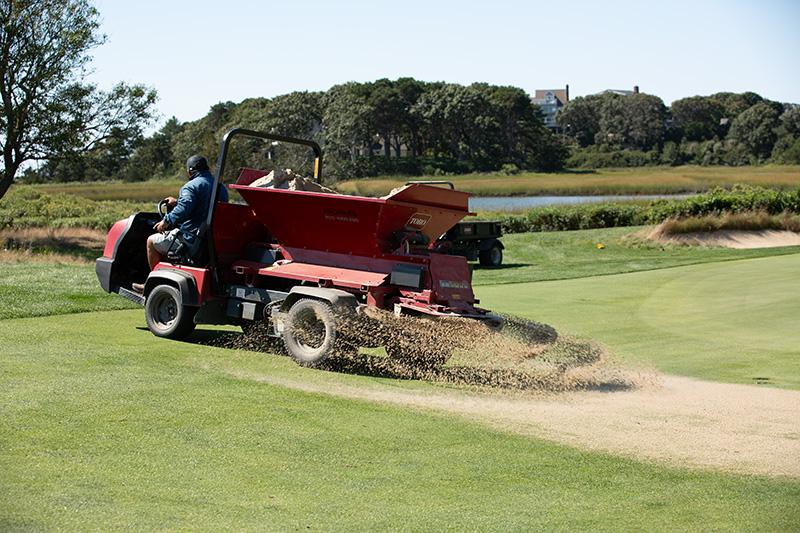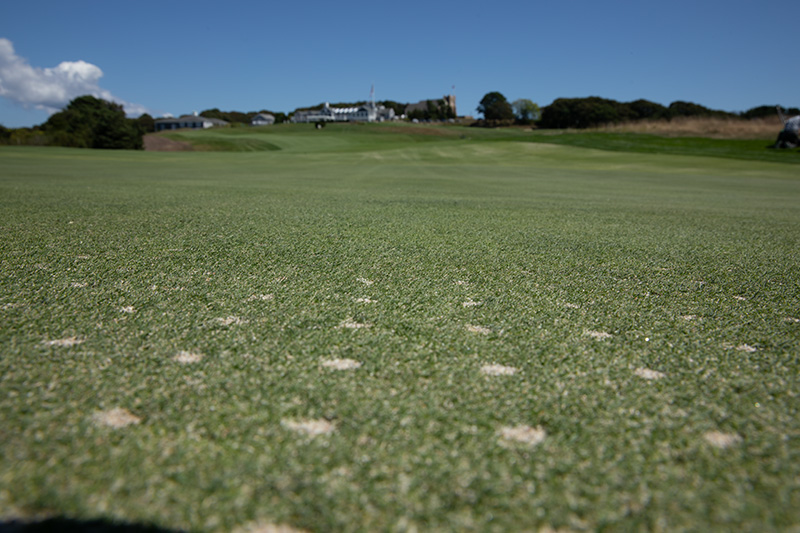
The team at Hyannisport Club on Cape Cod in Massachusetts has recently found success by interseeding their greens with Tee-2-Green bentgrass. Photos courtesy of Tee-2-Green
Editor's note: The following article was created in partnership with Tee-2-Green. All product claims, research cited and other information is directly from the company.
With pedigree comes high expectations. It’s like carrying the Kennedy name in New England — it means something to people. So it’s fitting that at Hyannisport Club, on the south shore of Cape Cod in Massachusetts, the Kennedys have been involved in the Club for the better part of the last 100 years. It’s not lost on the superintendent, Thomas Colombo, CGCS, that this star power means that the course needs to live up to the hype.
Presidential connection
“The Kennedy family arrived way back in the late 1920s. This was our president’s home course,” Colombo says. “He didn’t want to be seen as a ‘golfing president,’ so he rarely played 18 holes.”
Following President Dwight D. Eisenhower, JFK wanted to make sure he was perceived as hardworking, so he rarely played 18 holes to stay out of the limelight. Instead, John F. Kennedy commonly played the “inside five,” holes 1, 2 and 16-18. The president could essentially tee it up on hole 1 and be putting out on 18 in a matter of 45 minutes. “I’m sure that the president enjoyed the tranquility and beauty of the Hyannisport Club setting just as much as the golf course itself,” Colombo says. “There are spectacular views of the Hall’s Creek Estuary and Nantucket Sound from every hole on the golf course. The tidal marsh comes into play on six of the 18 holes out there.”
The rest of this pristine course hugs the coast, with water coming into play on almost every hole. The saltwater and the threat of storm surge make for unique maintenance challenges, but we’ll get to that. More on the Kennedys for now:
“[JFK’s] family still resides here, and they’re quite active in the club,” Colombo says. A 40-year GCSAA member, Colombo was born and raised on Cape Cod. Having spent his entire career managing golf course turf in a seaside environment, he understands that keeping Hyannisport up to a presidential standard is a tall order, and it’s a challenge he’s willing to face.

A favorite spot of John F. Kennedy, Hyannisport Club carries a historic legacy, as well as unique needs from its location on Nantucket Sound.
Massachusetts masterpiece
Located 90 minutes south of Boston, Hyannisport sits right on Nantucket Sound and carries a tremendous history. Three of the founding fathers of American golf have touched the ground at Hyannisport Club. John Reid, the president of St. Andrews Golf Club, N.Y., and co-founder of the USGA, helped lay out the first six holes in 1897, then known as Seaside Golf Links. In 1902, Alex Findlay, Scottish professional and architect, expanded Hyannisport Club to nine holes.
“In 1913, Donald Ross was hired when the club acquired a few more acres and stretched it out to a shorter 18-hole course, then a 5,033 yard par 67,” Colombo explains. “Ross was invited back in 1930 when the club acquired the last of the acreage, 40 additional acres to the west, which is essentially the golf course we play today. The par-71 course is relatively short on paper at 6,455 yards. However, the wind, green contours and the placement of hazards provide a good test for all golfers.”
The result is the existing championship-level, Audubon-certified gem. But of course, it all comes down to the grass.
“Being an older course, our standard grass on the greens is poa annua, although we interseed with the newer [bentgrasses],” Colombo says. “It’s old school, you can see the different grasses. Fairways and tees are a mix of poa, bentgrass, fescue, and perennial rye.”
The course also features native grass in its links-style design, which Colombo says helps frame the picture. “It really accents the golf course, providing aesthetic appeal and strategy off the tee so you have to place your ball in certain spots.”
Coastal challenges
While the coastal setting provides beauty and mystique, it also has particular maintenance needs.
“The setting is pretty unique,” Colombo says. “We’re always influenced by the wind and what Mother Nature dishes out on a given day. There’s a good number of holes along hazards such as a salt marsh.”
With a wide range of coastal weather conditions, Colombo and his crew have to be ready for nearly anything. “The biggest challenge we have is we’re at the mercy of storm surge, high tides, and even a moon high tide. It can impact certain low areas of the golf course,” he says. “We get salt marsh grass that washes up when the tide recedes and we have to physically pick it up and remove it before we institute mitigation procedures, like gypsum applications.”
Even the ever-present wind can cause a last-minute change of plans for the team. “If you are trying to schedule an application to any of your turf areas, you could come in in the morning and find that winds are greater than 10 miles per hour, then we have to wait it out and hope for another day,” Colombo says.
But there are also great benefits to the coastal environment, and not just the views. Colombo explains that “we get good air movement, unlike some of our counterparts inland.”

For successful interseeding, Thomas Colombo, CGCS, and his team start by aerating and vacuuming half-inch cores before rolling and applying topdressing sand.
Insights into interseeding
In an effort to keep the course in pristine condition, Colombo has been interseeding the greens recently to help strengthen them. It’s a tried-and-true process he’s used for decades.
“This is my 37th year as a golf course superintendent, and I’ve worked at three different golf courses on Cape Cod [...] I’ve instituted interseeding at all three,” he says. “It became more common for us when the finer bentgrasses came out. They could tolerate lower mowing heights, outcompete Poa, and survive the different stresses.”
Interseeding at the course provides ongoing maintenance and operational benefits as well. Colombo says he’s noticed that, “it certainly has reduced our inputs in terms of disease and fungicide applications.”
Colombo’s process of interseeding includes aerating half-inch cores, vacuuming the cores, and rolling to help smooth and firm the surfaces. He then applies a USGA spec topdressing sand, drags with a steel mat, brush in, and turbine blow any remaining sand where needed to ensure even application. Finally, they use a Blec overseeder which creates additional holes and opportunities for seed establishment.
The key ingredient is timing. “The time of year is key, and we usually interseed in September. With the soil being warm, we get the best germination, and combining it with aeration means the seeds get into the aeration holes, and we just water it in,” Colombo says.
The last step for Colombo is to apply a granular fertilizer and resume mowing about two days later. He expects seedlings to appear within a week.
Bentgrass buy-in
Colombo shares that he’s using Pure Distinction bentgrass from Tee-2-Green for his interseeding efforts, and he’s impressed by the results. “It can tolerate the low cut and really has performed well. It's got better cold and heat tolerance as well as disease tolerance,” he says.
Colombo says Tee-2-Green has also helped reduce turf disease on the greens. When I got here in 2008, there was a fair amount of crown rot and anthracnose on the weaker poa annua species on the greens. Interseeding with the newer Tee-2-Green bentgrass varieties has been a game changer in terms of maintaining quality putting surfaces.”
In his decades of experience, Colombo speaks highly of Tee-2-Green bentgrass and its place in the industry. “I definitely vouch for the positive effects of Pure Distinction and other Tee-2-Green bentgrass seed varieties,” he says. “It's been a staple in the industry. If you experience any kind of weak turf, it's a great competitive bentgrass variety that can tolerate the different stresses, whether it's mowing height, mechanical, heat, cold, or disease. I'd highly recommend it to another superintendent.”

Colombo says he typically expects seedlings to appear within a week after the interseeding process is complete.
The satisfying results
Regardless of the maintenance tactic, there’s no doubt the most rewarding part is seeing the impact it has on the course. “It’s just nice to see the results, to see the grass growing in the aeration holes a short time after interseeding,” Colombo says.
In a two-year period of interseeding, it has been a significant transformation for Colombo and the course. He adds, “My weakest greens became my strongest greens.”
But the process is never done, and Colombo looks ahead to how the course evolves with these practices. “I expect to see some good germination and just continue to strengthen the surfaces. That allows us to highly manage them and groom them throughout the season.”
Gratitude is key
For a superintendent at any course, but especially one with high expectations, it can be easy to focus on the details and not zoom out to see the bigger picture. In order for Colombo and his team to meet their club’s high standards, they need to perform from a place of gratitude, not just for the course, he says, but for the landscape and the nature around them.
“The best part of my job is coming to this beautiful site every day,” Colombo says. “Smelling the fresh salt air, seeing the habitat, the wildlife and looking out for its best interest.”
The Hyannisport Club legacy continues, with a goal of evolving and improving, while also remaining true to the history of the course.
“There’s a lot of tradition with families that have been here for generations, and they love their golf course,” Colombo says. “We’re continuing to improve what we have, and take in the beautiful site. It's a place that everyone loves to come to, and I’m fortunate to be here.”